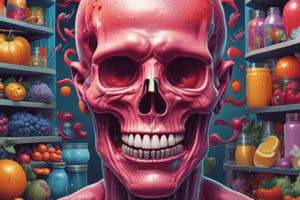Podcast
Questions and Answers
According to Thomas Szasz, what is the condition for treating a person for mental illness?
According to Thomas Szasz, what is the condition for treating a person for mental illness?
- The person considers their symptoms a problem (correct)
- It is culturally appropriate to do so
- The person suffers from a personality disorder
- A complete psychodynamic formulation has been done
What does the term 'psychopathology' literally mean?
What does the term 'psychopathology' literally mean?
- Disorder of feelings
- Sickness of the mind (correct)
- Abnormality of thought
- Disease of the brain
What is the primary characteristic of psychoses?
What is the primary characteristic of psychoses?
- Enduring maladaptive patterns of thought
- Chronic disturbances in interpersonal functioning
- Loss of touch with reality (correct)
- Repetitive interpersonal problems
What is the main idea behind Thomas Szasz's view on mental illness?
What is the main idea behind Thomas Szasz's view on mental illness?
What is the term for problematic patterns of thought, feeling or behaviour that disrupt an individual's sense of well-being, social or occupational functioning?
What is the term for problematic patterns of thought, feeling or behaviour that disrupt an individual's sense of well-being, social or occupational functioning?
What is the primary difference between neurotic symptoms and psychotic states?
What is the primary difference between neurotic symptoms and psychotic states?
What is the term for gross disturbances involving a loss of touch with reality?
What is the term for gross disturbances involving a loss of touch with reality?
What is the term for enduring maladaptive patterns of thought, feeling, and behaviour that lead to chronic disturbances in interpersonal and occupational functioning?
What is the term for enduring maladaptive patterns of thought, feeling, and behaviour that lead to chronic disturbances in interpersonal and occupational functioning?
According to which model, people with an underlying vulnerability may develop a disorder under stressful circumstances?
According to which model, people with an underlying vulnerability may develop a disorder under stressful circumstances?
What type of diagnostic system does DSM-5 use?
What type of diagnostic system does DSM-5 use?
What is one of the common symptoms exhibited by children with attention-deficit hyperactivity disorder?
What is one of the common symptoms exhibited by children with attention-deficit hyperactivity disorder?
What is the primary focus of the first question a psychodynamic psychologist asks?
What is the primary focus of the first question a psychodynamic psychologist asks?
What is the primary cause of psychoses according to the aetiology?
What is the primary cause of psychoses according to the aetiology?
Approximately what percentage of Australians had sampled illegal drugs in the 12 months preceding a recent study?
Approximately what percentage of Australians had sampled illegal drugs in the 12 months preceding a recent study?
Which of the following theories is NOT integrated by cognitive-behavioural practitioners?
Which of the following theories is NOT integrated by cognitive-behavioural practitioners?
Why are positive symptoms of schizophrenia so named?
Why are positive symptoms of schizophrenia so named?
What does the biological approach to psychopathology take into consideration?
What does the biological approach to psychopathology take into consideration?
What is an example of a negative symptom of schizophrenia?
What is an example of a negative symptom of schizophrenia?
What is the estimated heritability of schizophrenia according to a study of twins born in Finland between 1940 and 1957?
What is the estimated heritability of schizophrenia according to a study of twins born in Finland between 1940 and 1957?
What approach to psychopathology looks for the roots of mental disorders in the broader social context?
What approach to psychopathology looks for the roots of mental disorders in the broader social context?
What does the diathesis-stress model propose about the development of schizophrenia?
What does the diathesis-stress model propose about the development of schizophrenia?
What do family systems theorists examine in assessing the family?
What do family systems theorists examine in assessing the family?
What is the term for constellations of symptoms that tend to occur together?
What is the term for constellations of symptoms that tend to occur together?
What is a characteristic of attention-deficit hyperactivity disorder?
What is a characteristic of attention-deficit hyperactivity disorder?
What is the primary focus of the third question a psychodynamic psychologist asks?
What is the primary focus of the third question a psychodynamic psychologist asks?
What does the second question a psychodynamic psychologist asks focus on?
What does the second question a psychodynamic psychologist asks focus on?
What is NOT a focus of the biological approach to psychopathology?
What is NOT a focus of the biological approach to psychopathology?
What neurotransmitter may be important in addition to dopamine in schizophrenia, as suggested by PCP's effects?
What neurotransmitter may be important in addition to dopamine in schizophrenia, as suggested by PCP's effects?
In the dopamine hypothesis, which neural circuits are responsible for positive symptoms in schizophrenia?
In the dopamine hypothesis, which neural circuits are responsible for positive symptoms in schizophrenia?
What is a characteristic abnormality in the brain structure of individuals with schizophrenia?
What is a characteristic abnormality in the brain structure of individuals with schizophrenia?
What environmental variable is particularly important in the onset and course of schizophrenia?
What environmental variable is particularly important in the onset and course of schizophrenia?
Which disorder is depression most likely to be associated with?
Which disorder is depression most likely to be associated with?
What is a characteristic of depression in terms of gender differences in Australia?
What is a characteristic of depression in terms of gender differences in Australia?
What does Aaron Beck call the mechanisms by which a depressed person transforms neutral or positive information in a depressive direction?
What does Aaron Beck call the mechanisms by which a depressed person transforms neutral or positive information in a depressive direction?
In the dopamine hypothesis, what is the role of subcortical circuits projecting from the midbrain to the prefrontal cortex?
In the dopamine hypothesis, what is the role of subcortical circuits projecting from the midbrain to the prefrontal cortex?
What is the term for the tendency of family interactions to be characterized by criticism, hostile interchanges, and emotional over-involvement?
What is the term for the tendency of family interactions to be characterized by criticism, hostile interchanges, and emotional over-involvement?
What is the prevalence of depression among Australian females aged between 25-34 years, according to the Australian Institute for Health and Welfare?
What is the prevalence of depression among Australian females aged between 25-34 years, according to the Australian Institute for Health and Welfare?
What is the term for mechanisms by which a depressed person transforms neutral or positive information in a depressive direction?
What is the term for mechanisms by which a depressed person transforms neutral or positive information in a depressive direction?
What percentage of the population is affected by generalised anxiety disorder?
What percentage of the population is affected by generalised anxiety disorder?
What is the characteristic of veterans who are most likely to develop PTSD?
What is the characteristic of veterans who are most likely to develop PTSD?
Which disorder is characterised by attacks of intense fear and feelings of doom or terror not justified by the situation?
Which disorder is characterised by attacks of intense fear and feelings of doom or terror not justified by the situation?
What is the new disorder included in the DSM-5?
What is the new disorder included in the DSM-5?
What are personality disorders characterised as?
What are personality disorders characterised as?
What is borderline personality disorder characterised by?
What is borderline personality disorder characterised by?
Which of the following is not a personality disorder listed in the DSM-5?
Which of the following is not a personality disorder listed in the DSM-5?
What is the prevalence of personality disorders in the general population estimated to be?
What is the prevalence of personality disorders in the general population estimated to be?
What is typical of depressed patients identified by Beck?
What is typical of depressed patients identified by Beck?
Substance-related disorders are characterised by:
Substance-related disorders are characterised by:
Which personality disorder is more prevalent in women?
Which personality disorder is more prevalent in women?
What is the term for a set of hypotheses about a patient's personality structure and the meaning of the symptom?
What is the term for a set of hypotheses about a patient's personality structure and the meaning of the symptom?
According to which theory, a diagnosis of mental illness is simply a way to categorise individuals whom a society considers deviant?
According to which theory, a diagnosis of mental illness is simply a way to categorise individuals whom a society considers deviant?
What is the term for perceptual experiences that distort or occur without external stimulus?
What is the term for perceptual experiences that distort or occur without external stimulus?
What is characterised by a period of abnormally elevated or expansive mood?
What is characterised by a period of abnormally elevated or expansive mood?
What is the term for methods that families use to preserve equilibrium?
What is the term for methods that families use to preserve equilibrium?
Which approach to psychopathology integrates an understanding of classical and operant conditioning with a cognitive-social perspective?
Which approach to psychopathology integrates an understanding of classical and operant conditioning with a cognitive-social perspective?
What is the term for common patterns of thought, feeling, or behaviour that disrupt an individual's sense of well-being, social or occupational functioning?
What is the term for common patterns of thought, feeling, or behaviour that disrupt an individual's sense of well-being, social or occupational functioning?
Which personality disorder is more prevalent in men?
Which personality disorder is more prevalent in men?
Which diagnostic category is used to describe individuals who seem to have attributes of both schizophrenia and psychotic depression?
Which diagnostic category is used to describe individuals who seem to have attributes of both schizophrenia and psychotic depression?
What is the characteristics of seasonal affective disorder (SAD)?
What is the characteristics of seasonal affective disorder (SAD)?
What is the term for a disturbance of childhood characterized by persistent violation of societal norms and the rights of others?
What is the term for a disturbance of childhood characterized by persistent violation of societal norms and the rights of others?
When do most forms of schizophrenia begin?
When do most forms of schizophrenia begin?
What is the relationship between dopamine and schizophrenia?
What is the relationship between dopamine and schizophrenia?
How long do major depressive episodes usually last?
How long do major depressive episodes usually last?
What is NOT a typical symptom of mania?
What is NOT a typical symptom of mania?
What is the term for a person who experiences periods of mania and depression?
What is the term for a person who experiences periods of mania and depression?
What do psychodynamic theories of depression focus on?
What do psychodynamic theories of depression focus on?
What is NOT a compulsion?
What is NOT a compulsion?
Flashcards are hidden until you start studying
Study Notes
Abnormal Psychology
Thomas Szasz's View
- According to Thomas Szasz, a person should only be treated for mental illness if they consider their symptoms a problem.
Psychopathology
- Refers to problematic patterns of thought, feeling or behaviour that disrupt an individual's sense of well-being, social or occupational functioning.
Psychoses
- Are chronic and severe disturbances that substantially inhibit the capacity to love and to work.
- Can involve a loss of touch with reality (e.g., hearing voices, believing in conspiracy theories).
Psychodynamic Psychology
- Asks three questions to create a set of hypotheses about a patient's personality structure and meaning of their symptoms:
- What does the patient wish for and fear?
- What psychological resources does the person have at their disposal?
- How does the patient experience themselves and others?
Aetiology of Psychoses and Neuroses
- Psychoses result primarily from biological abnormalities.
- Neuroses and personality disorders stem more from environmental experiences.
Cognitive-Behavioural Practitioners
- Integrate an understanding of:
- Classical conditioning
- Operant conditioning
- Cognitive-social perspective
Biological Approach
- Looks for the roots of mental disorders in:
- Genetic factors
- Brain regions
- Brain circuitry
Systems Approach
- Examines the physical and psychological limits of the family and its subsystems.
- Includes looking at family boundaries.
Clinical Syndromes
- Constellations of symptoms that tend to occur together.
Diathesis-Stress Model
- Proposes that people with an underlying vulnerability may develop a disorder under stressful circumstances.
Attention-Deficit Hyperactivity Disorder (ADHD)
- Characterized by impulsiveness, inattention, and hyperactivity.
Schizophrenia
- Heritability estimated at 83%.
- Positive symptoms: delusions, hallucinations, loose associations.
- Negative symptoms: blunted emotional response, lack of motivation, socially inappropriate behaviour, and intellectual impairment.
Dopamine Hypothesis
- Suggests that individuals with schizophrenia have excess dopamine in subcortical circuits.
Environmental Variables
- Expressed emotion (criticism, hostility, emotional over-involvement) can contribute to the onset and course of schizophrenia.
Mood Disorders
- Depression is likely to be associated with anxiety disorders.
- Women are more likely to suffer from depression than men.
Cognitive Distortions
- Mechanisms by which a depressed person transforms neutral or positive information in a depressive direction.
Generalised Anxiety Disorder
- Characterized by persistent anxiety at a moderate but disturbing level and excessive and unrealistic worry about life circumstances.
Post-Traumatic Stress Disorder (PTSD)
- More likely to develop in veterans with lower IQ.
Panic Disorder
- Characterized by attacks of intense fear and feelings of doom or terror not justified by the situation.
Eating Disorders
- Binge eating disorder is a new disorder included in the DSM-5.
Personality Disorders
- Chronic and severe disturbances that substantially inhibit the capacity to love and to work.
- Examples include borderline, histrionic, and schizotypal personality disorders.
Schizoaffective Disorder
- A diagnostic category used to describe individuals who seem to have attributes of both schizophrenia and psychotic depression.
Seasonal Affective Disorder (SAD)
- More frequent during the winter months due to lack of sunlight.
Conduct Disorder
- A disturbance of childhood characterized by persistent violation of societal norms and the rights of others.
Schizophrenia Onset
-
Most forms of schizophrenia begin in the late teens and early twenties.### Amphetamines and Psychosis
-
Amphetamines increase dopamine activity, leading to psychotic-like symptoms such as paranoia and hallucinations in normal people when taken in high doses.
Major Depressive Episodes
- Major depressive episodes typically last about 5 months.
Mania Symptoms
- Symptoms of mania include an inflated sense of self, racing thoughts, and a constant need to talk.
- People during a manic episode are not persistent, and their thoughts and behavior jump from one thing to another.
Bipolar Disorder
- Bipolar disorder is characterized by periods of mania and depression.
- Individuals with bipolar disorder experience both depression and mania.
Psychodynamic Theories of Depression
- Psychodynamic theories of depression focus on motivation, including identification with a depressed or belittling parent or an attachment history that predisposes fear of rejection or abandonment.
Compulsions and Obsessions
- Compulsions include counting, hand washing, and touching.
- Repetitive thoughts are an obsession, not a compulsion.
Substance-Related Disorders
- Substance-related disorders are characterized by continued use of a substance that negatively affects psychological and social functioning.
Personality Disorders
- Borderline personality disorder is more prevalent in women.
- Antisocial personality disorder is more prevalent in men.
Labelling Theory
- Labelling theory suggests that a diagnosis of mental illness is simply a way to categorize individuals whom a society considers deviant.
Psychodynamic Formulation
- A psychodynamic formulation is a set of hypotheses about a patient's personality structure and the meaning of the symptom, used to assess psychopathology.
Cognitive-Behavioural Therapy
- Cognitive-behavioural therapists integrate an understanding of classical and operant conditioning with a cognitive-social perspective.
Family Systems Model
- Family systems model suggests that families use homoeostatic mechanisms to preserve equilibrium.
Hallucinations and Schizophrenia
- Hallucinations are perceptual experiences that distort or occur without external stimulus, and are common in individuals suffering from schizophrenia.
- Auditory hallucinations (hearing voices) are the most frequent kind experienced by people suffering from schizophrenia.
Mania
- Mania is characterized by a period of abnormally elevated or expansive mood, during which an individual has an inflated sense of self that reaches grandiose proportions.
- During a manic episode, people generally require less sleep, experience their thoughts as racing, and feel a constant need to talk.
Studying That Suits You
Use AI to generate personalized quizzes and flashcards to suit your learning preferences.





